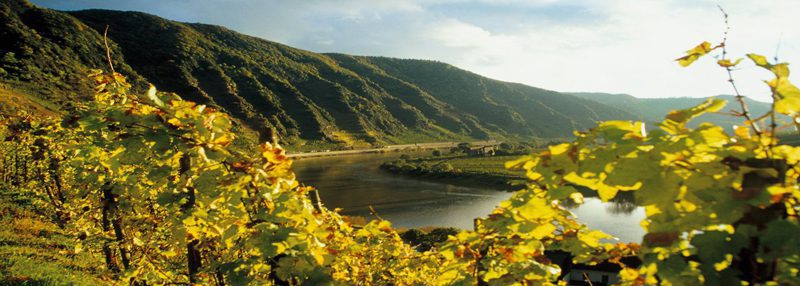It is one of the most impressive wine-growing regions in the world, located in the valleys and slopes of the Moselle, Saar and Ruwer rivers. Its continuously meandering riverbeds wind in narrow meanders through a cultural landscape in which the Romans have been cultivating vines for 2000 years.
 The Mosel region is the oldest wine-growing region in Germany and the largest of the areas made up of sloping hillsides. The sweet, dry, or slightly fruity Riesling wines made in this region are the most characteristic in Germany.
The Mosel region is the oldest wine-growing region in Germany and the largest of the areas made up of sloping hillsides. The sweet, dry, or slightly fruity Riesling wines made in this region are the most characteristic in Germany.
On the banks of these rivers, about 9,000 hectares are dedicated to the cultivation of vines. The sloping hillsides and terraces, facing south or southwest, provide an excellent microclimate for vines and other exotic plants and animals. Thanks to this microclimate, the elegant Riesling mineral wines that grow on the slopes of the Moselle, Saar and Ruwer are among the best white wines in the world.
The main peculiarities of these wines are due not only to their microclimate but also to the characteristics of the soil and their proximity to the three rivers, which allows for better heat storage, which, together with the tempering function of the river, provide the ideal conditions for these grapes to ripen with the right heat and express their characteristic aroma. Given the topography of the terrain, the cultivation of vines on these narrow terraces is very complicated and sometimes almost inaccessible, making the mechanization of the work unthinkable. Even so, it is the cheapest wine region in Germany because of its relatively high yields.
The key lies in the winegrowers of the area, and in the history of viticulture in the region. With the secularization of the large ecclesiastical domains, a powerful wine trade was established, leading to the Moselle region today having six of the largest wineries in the country, and bottling a large part of the European production.
 The undisputed queen in this area is the cultivation of Riesling grape vines, which is not only characteristic of the area, but of the whole of Germany, with an area of 20,794 hectares of vineyards, which is more than 20% of the country’s total. The Moselle region alone concentrates more than 5,000 hectares of this grape variety, 60% of the cultivation in the area.
The undisputed queen in this area is the cultivation of Riesling grape vines, which is not only characteristic of the area, but of the whole of Germany, with an area of 20,794 hectares of vineyards, which is more than 20% of the country’s total. The Moselle region alone concentrates more than 5,000 hectares of this grape variety, 60% of the cultivation in the area.
Although Riesling has been cultivated since the s. XI, it is not until the s. XVII and XVIII when it really manages to consolidate. It is a grape suitable for temperate and cool climates, for its optimal ripening of sugars and acids. It is one of the varieties that best expresses the particularities of the land where it is grown. Therefore, in its wide range it covers from honeyed flavors to mineral and fruity characters. Its wines have a pale yellow color with greenish and golden yellow reflections, are fruity, with aromas of apple, peach and citrus.
 The Müller-Thurgau is the other great variety of the Moselle area. Equally appreciated by winegrowers, its origin is a cross between Riesling and Madeleine Royale, created in 1882 by Hermann Müller. Fast ripening in fertile soils, it obtains good results in the production of wines with light acidity, soft and complete.
The Müller-Thurgau is the other great variety of the Moselle area. Equally appreciated by winegrowers, its origin is a cross between Riesling and Madeleine Royale, created in 1882 by Hermann Müller. Fast ripening in fertile soils, it obtains good results in the production of wines with light acidity, soft and complete.
We do not forget an autochthonous specialty of the region that is now almost exclusively grown in the upper Mosel: the Elbling variety, which is the basis for the production of the highly appreciated Seckt. As for red grapes, Blauer Spätburgunder, Dornfelder and Regent are some of the varieties cultivated in the region, occupying 10% of the region.




